Vanishing memorials and otherworldly landscapes in America's craziest state
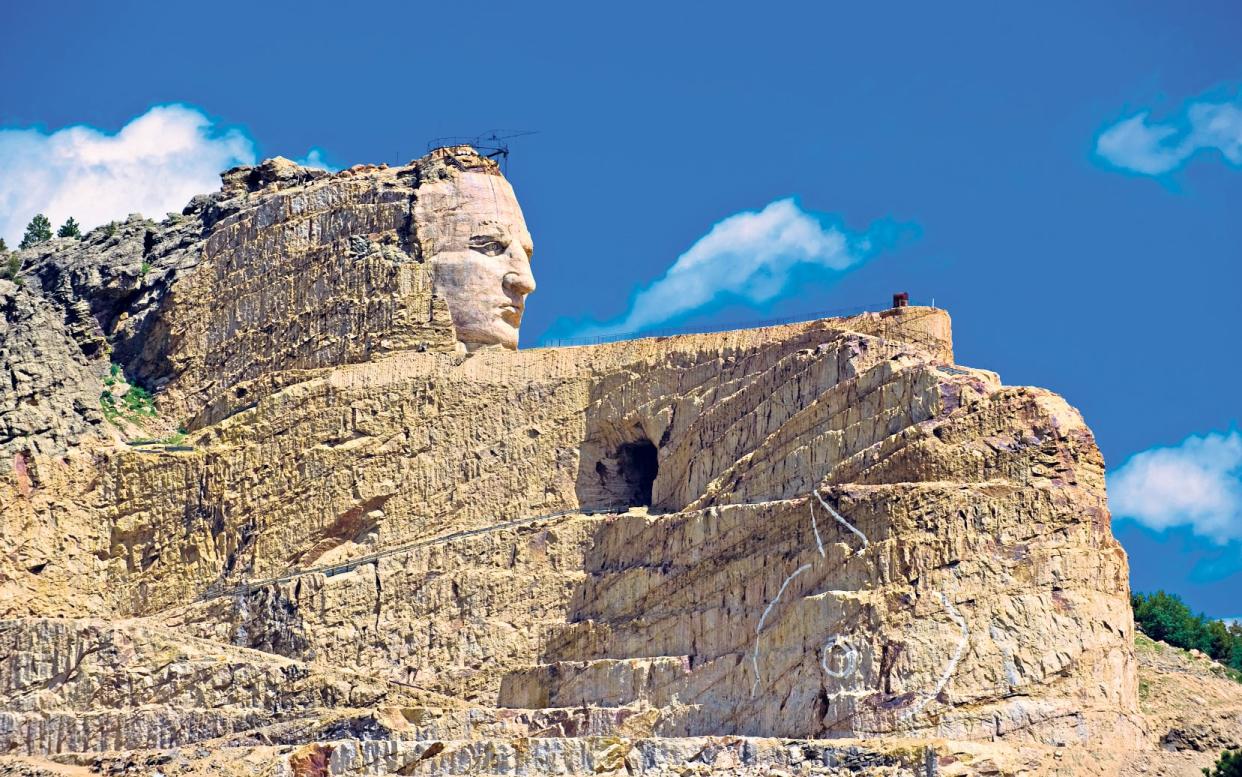
The morning I went to see them, South Dakota’s most famous man-made tourist attractions had vanished. That can happen in spring. Two days earlier I’d experienced dazzling sun followed by horizontal rain; now fog had seeped in through the ponderosa pines of the Black Hills and swallowed the peaks.
Over my “Monumental Breakfast” in Carver’s Café, I peered across at Mount Rushmore (named in 1885 after a New York lawyer who was checking mining claims). There, between 1927 and 1941, Gutzon Borglum, the son of Danish Mormon immigrants, dynamited and hammered into existence the images of four presidents – George Washington, Thomas Jefferson, Theodore Roosevelt and Abraham Lincoln – that he declared would “endure until the wind and the rain alone shall wear them away”. Occasionally the fog would briefly drift or lift to reveal a presidential brow or nose, but never the whole panorama. Endurance wasn’t foremost in my mind; more the vanity of sculptors, and the transience of politicians.
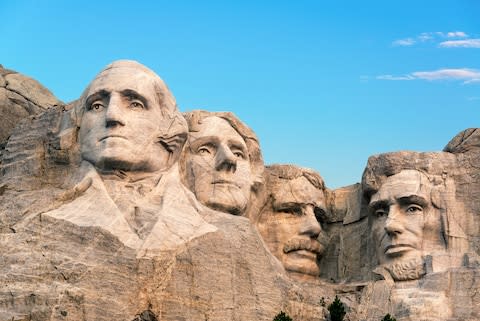
Sixteen miles away, at the Crazy Horse Memorial, the fog was thicker still. Here, exactly 70 years ago, the Boston-born Korczak Ziolkowski began blasting granite to carve an answer to Mount Rushmore; an image commissioned by the Oglala Lakota chief Henry Standing Bear, who told him: “My fellow chiefs and I would like the white man to know that the red man has great heroes also.” The hero he had in mind was Crazy Horse, who with Sitting Bull engineered General George Custer’s defeat at Little Bighorn, their people’s greatest triumph in the American Indian Wars.
In scale and ambition, Ziolkowski’s plan – to depict a mounted Crazy Horse, left arm and pointing finger stretched over his horse’s mane – dwarfs Rushmore. It is designed to be 641ft long and 563ft high. All four presidential heads, each 60ft tall, would fit inside Crazy Horse’s head and flowing hair.
Or so I had read. When I arrived, I was in no position to judge. Visibility was so poor that a car had crashed just beyond the entrance kiosk.
Vicky Engelhaupt, the cheery soul driving me around, apologised on behalf of the state tourist board: “You’re thinking those blue skies in our pictures are Photoshopped in. They’re not – honestly.” Confirmation would come later, but while we waited for Mother Nature to raise the curtain on the main event, there were plenty of diversions.
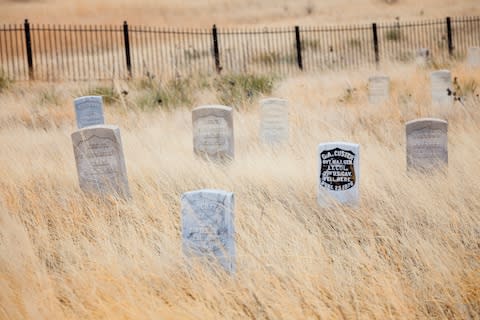
Three million tourists a year visit Mount Rushmore; a million visit the Crazy Horse Memorial. At both sites they’re catered for with introductory video, exhibition, sculptor’s studio, café and souvenir shop.
The foundation behind the memorial aims “to protect and preserve the culture, tradition and living heritage of the North American Indians”. Besides offering a fascinating three-wing Indian Museum of North America and a two-floor educational and cultural centre, it runs a summer school with the state university that is helping to cut the high dropout rate among American Indian students. It also aims, “when practical”, to set up a medical training centre.
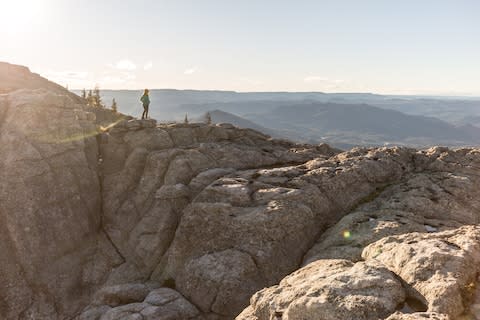
The Black Hills are sacred to American Indians, and some regard the Crazy Horse Memorial as no less of a spiritual and environmental violation than the Mount Rushmore Memorial. But few can doubt the commitment of the Ziolkowski family: Korczak told his children that if they moved away they needn’t bother coming back.
When he died at 74 in 1982, his wife, Ruth, took over as leader until her own death, four years ago. Four of their 10 children – led by Jadwiga – and some of their 23 grandchildren are still at work. If the pace seems glacial – the face took 10 years – that is partly because the foundation refuses government handouts and relies on donations and entry fees.
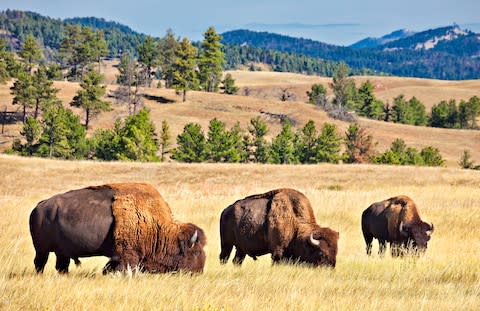
On the introductory video, I’d heard Jadwiga say of the carving: “I hope my children will be able to see it pretty well completed.” Terry DeRouchey, vice-president of visitor services, raised an eyebrow when I mentioned that. He referred me to what the foundation had said a couple of years ago: that within the next 10 to 15 years they would like to have finished Crazy Horse’s hand, arm and right shoulder, the 40ft hairline behind the face on both sides, and the top of the horse’s head. Right now, they are “down to within a foot of the final surface on the fingertip”. Yesterday, as part of a spring Volksmarch (there’s another on Sept 30), walkers were able to head for the top of the mountain and out towards that fingertip.
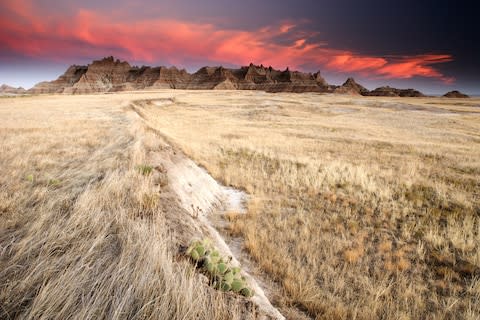
Many visitors to both memorials pause at Rapid City, which has presidential sculptures of its own, life-size and in bronze. On the corner nearest my hotel, I found John F Kennedy handing his son, John Jr, a toy plane. Elsewhere were Benjamin Harrison (23rd president), alone with birds in his garden; and Harry S Truman, brandishing with a grin a 1948 newspaper erroneously declaring his opponent to have won.
Neither the images on the mountains nor the ones on the streets would be there but for a state historian of the Twenties, Doane Robinson. He felt South Dakota was short of traffic-stopping attractions, and told Borglum the answer might be a “heroic sculpture of unusual character”.
Robinson, surely, can’t have got out much. Had he never walked in the Black Hills, where the pines, as Doris Day sang in the film Calamity Jane, “are so high that they kiss the sky above”? When I was in Custer State Park at the end of May, watching bison calves huddle close to mother, whole hillsides had been cleared of ponderosas and others were showing an unseasonal rust – the result of a fire last December that consumed 84 sq miles (217 sq km). Elsewhere, though, the pines were arrowing heavenwards. I got “cosy with those treetops” (as my pilot put it) on a brief helicopter trip with Black Hills Aerial Adventures.
And what about the Badlands? How could Robinson forget them, with their towering spires, plunging canyons and flat-topped tables from which the Lakota used to stampede the bison? There’s plenty to make you pull in there – though I’d recommend a stay of a night or two. This other-worldly landscape – which 65 million years ago was an inland sea – is at its best early and late, with a low sun revealing its layers and colours.
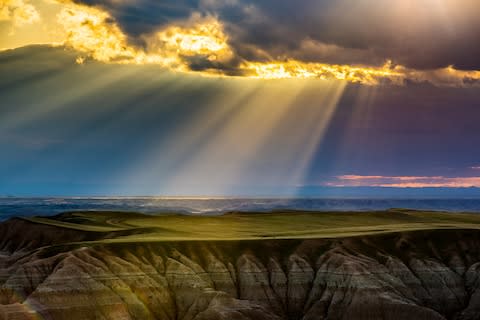
With Keegan Carda of the state tourist board, I spent a couple of days in the Badlands. Some of the time we hit the road with rangers: first with Tyson Nehring in the north, then with Vince Littlewhiteman in the south, which since 1976 has been run in an uneasy partnership between the National Park Service and the Oglala Lakota Nation – the eighth-largest American Indian reservation in the country.
The park covers 380 sq miles (984 sq km). Rangers are expected to serve also as police officers, firefighters and paramedics, and to answer questions from tourists who reckon some of the “bison” don’t look like the ones in the brochure.
The two men’s patches are vastly different. The north has Tarmac roads, viewpoints, a lodge and campground. The south is unsigned 4x4 country, where visitors need to have about them both maps and wits: much land is leased to ranchers, the “gumbo” clay turns treacherous when wet, and you might come across UXOs – unexploded ordnance. During the Second World War, residents were given a week to get out so the US Air Force could use the reservation for target practice.
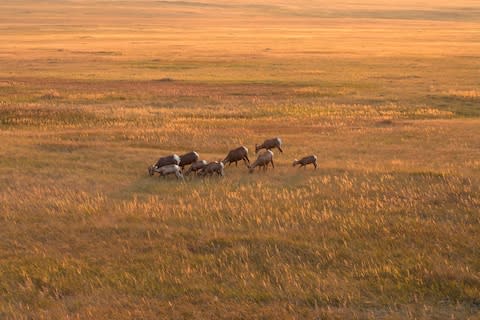
The bighorn sheep, less used to tourists, are wilder in the south, Vince reckons. So, too, are some of the fossil-hunters. Several times at night he has found armed men intent on a dig. When he’s outnumbered six to one, he adds: “All I can do is wave to them and say, ‘I’ll catch you another day.’”
Both rangers mentioned sights on their patch that weren’t what they used to be. Nothing they could do about it: the Badlands is one of the world’s most rapidly dissolving landscapes. The whole place is falling apart, being borne away by the wind and the rain and the White, Bad and Cheyenne rivers. If I were you, I’d go and see it as soon as you can.
How to get there
Michael Kerr was a guest of South Dakota Tourism (travelsouthdakota.com; greatamericanwest.co.uk) and America As You Like It (020 8742 8299; americaasyoulikeit.com). The latter offers an eight-night fly-drive from £1,445 per person sharing, including return flight from Heathrow to Rapid City on American Airlines (via Dallas Fort Worth), eight days’ car hire, two nights’ bed and breakfast at the Rushmore Hotel and Suites, Rapid City, one night, room only, at Cedar Pass Lodge in the Badlands National Park, one night’s B&B at the Comfort Inn, Hill City, two nights’ self-catering at Black Hills Wild Horse Sanctuary, Hot Springs, including a three-hour cross-country tour, and two nights’ B&B at the Holiday Inn Express, Custer.
Five essential stops in South Dakota
Journey Museum & Learning Centre
Brief yourself here (journeymuseum.org) in Rapid City before you hit the road. In a building representing the uplift of the Black Hills, you follow a path from the prehistoric to the present, taking in dinosaurs, archaeological digs and, in between, the often bloody history of encounters between American Indians and settlers.
Oglala Lakota College
The college (“rebuilding the Lakota nation through education”) is a beacon of hope on the Pine Ridge Indian Reservation, home to some 20,000 people and one of the poorest places in the US. A free tour with audio at its Kyle HQ (bit.ly/2shAvyx) tells the story of the Oglala Lakota from 1800 to 1890 – when at least 146 American Indians, including 18 children, were massacred at Wounded Knee.
USA most epic
Black Hills Wild Horse Sanctuary
Dayton Hyde used to say that wild horses couldn’t drag him away from his ranch in Oregon. Then in 1988 he saw hundreds penned in feedlots by the government in Nevada because there wasn’t grass on the range to sustain them. On his Black Hills spread (wildmustangs.com) they run free. Pop in for a tour, or book a couple of nights in a cabin.
Wall Drug
A drugstore Ted and Dorothy Hustead bought in Wall in 1931 struggled until she suggested putting signs on the highway offering free iced water. Now Wall Drug (walldrug.com), still in family hands, draws up to 20,000 people a day with a pharmacy museum, a café seating 530 amid a gallery of Western art, a travellers’ chapel, a shop with 6,000 pairs of cowboy boots, and a life-size robotic T rex (“re-skinned last year,” Rick Hustead told me).
Reptile Gardens
Opened in 1937 by Earl Brockelsby, whose party trick was to lift his hat and reveal a rattlesnake, Reptile Gardens (reptilegardens.com) is in Guinness World Records 2018 as “the largest reptile collection”, with 225 species. Freak-show elements linger, with keepers prising apart alligator jaws, but it’s educational, too, in displays debunking internet myths.

